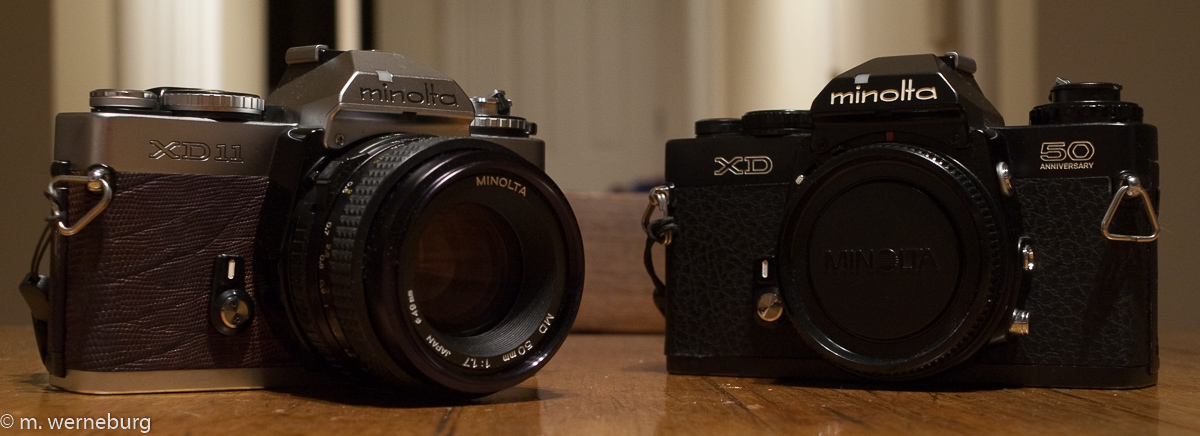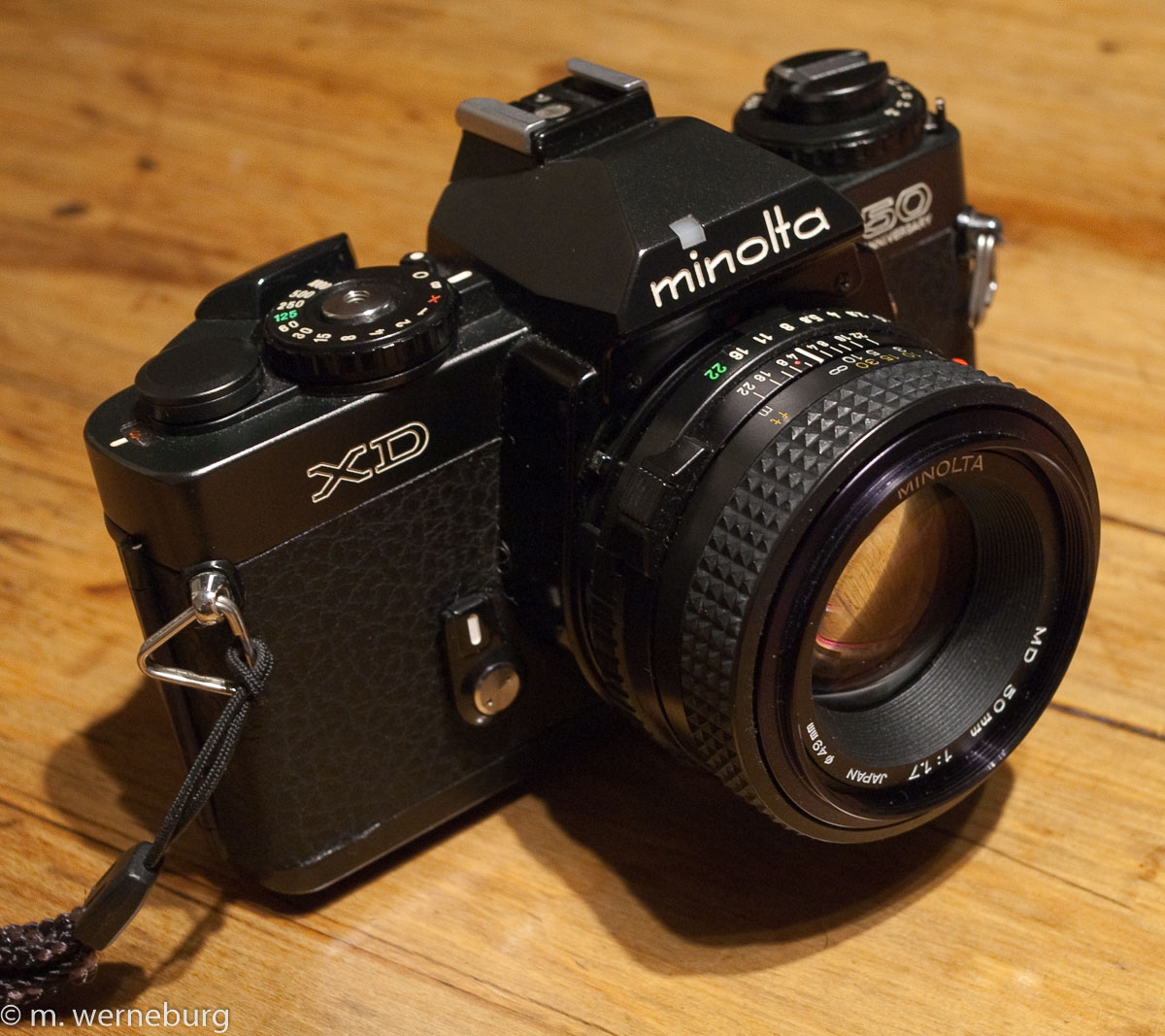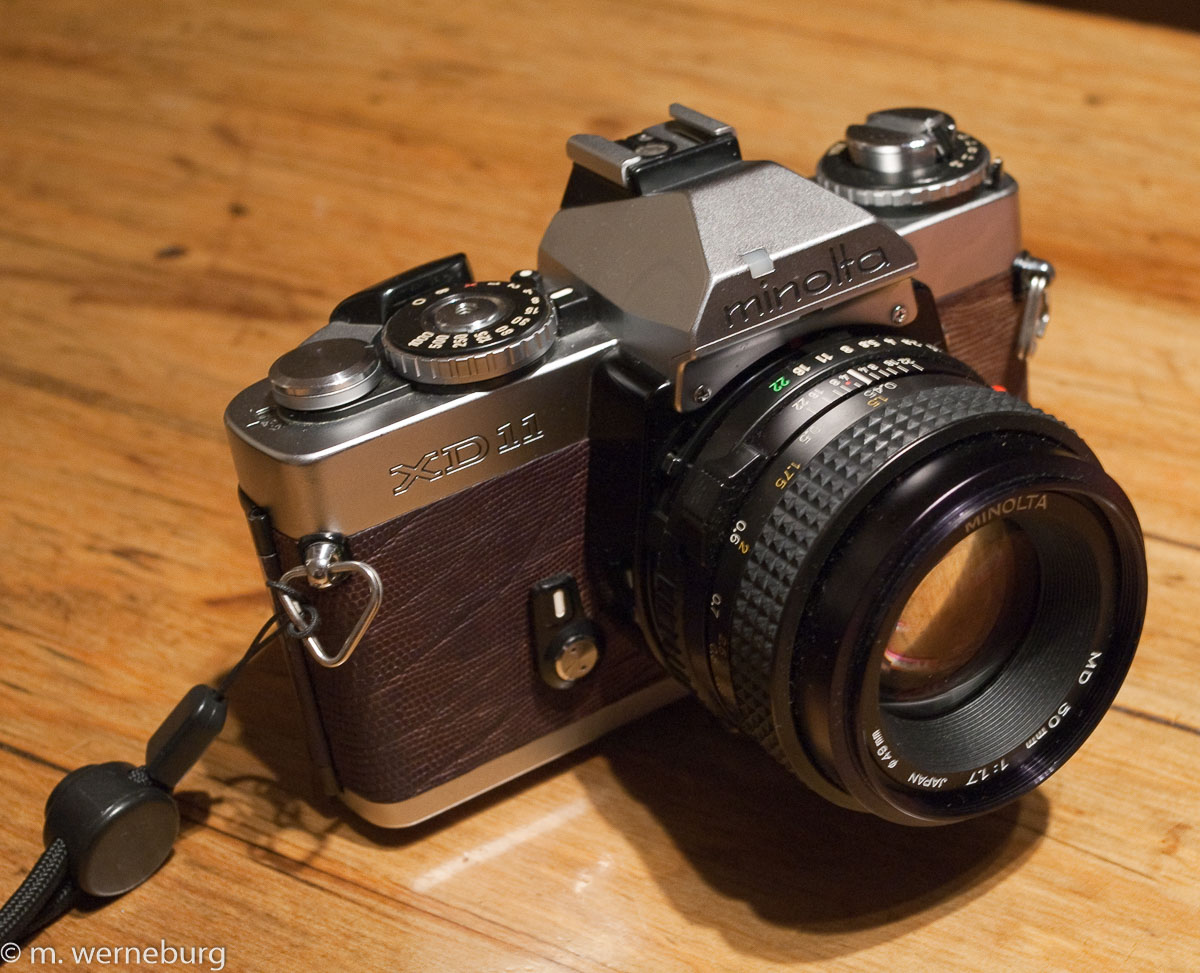review: Minolta XD - XD-11
2004.06.12 (updated : 2009.02.28)
The Minolta XD is a manual-focus camera from the 70's. It's been my favorite camera since I bought my first XD body back in late 2003 because it gets great results and it's a downright joy to use.
When it was introduced, this camera was the top of Minolta's X- line, and a competitor to such famous models as Canon's A-1. Minolta's ambition (partnering with Leica in this design) seems to have been to attract the serious-amateur market (if not the odd pro), and they assembled a product that was at once easy to use, supported by great features, and even great to look at. The XD was the first to provide both aperture-priority and shutter-priority modes in a single body, and was backed up by a state-of-the-art meter and an able shutter. As a result, it's a highly versatile tool that takes the user along way to pleasing results with a minimum of hassle.
Five years after buying my first body, I've bought a second on the strength of my respect for this camera. This remains my go-to camera, above even my digital SLR.

my two cameras
A more full review follows.
benefits
Briefly put, this camera has four chief benefits for a hobbyist photographer: flexibility in exposure control, controls that are well placed and easy to use, accurate light metering, and an all-in-one view of the settings through the viewfinder.
the meter
Due to its simple elegance, this is not a camera with a lot of modern "features", but its meter is far beyond anything else from the film era that I've used. The meter is center-weighted, as with many manual-focus film cameras. It excels in low light and remains capable through broad daylight and in trickier conditions with mixed or variable lighting.
While the robust meter is billed as centre-weighted, but I find that it is more strongly weighted than similar cameras towards the center of the image.
See the 1977 PopPhoto review for a map that shows the center-weighting to be slightly 'below' the center of the frame
. The meter is rated to EV 1 through EV 18, with off-the-film metering to precisely measure the amount of light striking the film during exposure. Off-the-film metering was one of the more sophisticated varieties available at the time of the camera's release, and remains extremely precise despite three decades of advances in film.
With the XD I seldom find bracketing to be necessary, as the meter is reliable. I use the center-weighted meter like I would a spot meter—identifying an area that I want to expose for, then adjusting with the manual controls. With the XD these controls amount to an exposure adjustment dial (+2/-2) and of course reverting to manual exposure settings outright.

50th anniversary model
the viewfinder
The versatility of having both automatic exposure modes is supported by the viewfinder, in which both shutter and aperture settings are prominently displayed. The presentation of this data depends on the exposure mode: when in aperture-priority, the aperture value appears at the bottom of the viewfinder and the shutter speed appears on the right, where a marker points to the derived value appropriate for correct exposure. When in shutter-priority mode, the shutter speed appears in a box in the lower-right corner of the viewfinder, and the aperture appears on the right—again marked according to the correct exposure. The viewfinder image itself, meanwhile, is a beautifully crisp and large image thanks to the Minolta Acute-Matte focusing screen, the 94% view coverage, and 0.87 magnification.
shutter
The shutter is of the vertical-travel variety and is particularly quiet when compared to contemporary Minolta cameras such as the X-700. The meter operates at a flash-sync of 1/100s, and when used with the X or PX series of flashes is very consistent. The shutter also has bulb and 1/100s mechanical modes that allow the camera to be used without a battery.
the controls
As I say, this camera is not laden-down with unnecessary controls. The short list of controls is:
- exposure override (+2/-2)
- depth-of-field preview
- adjustable shutter-release timer
- exposure mode selector (A, S, M)
- cable release socket
- film speed dial
- X socket for flash
On the dial for the manual exposure setting are three extra positions
- B (bulb)
- 'X' flash sync shutter speed (1/100s)
- 'O' battery-free shutter operation setting (also 1/100s)
All of these controls have an excellent engineered feeling to them. They're made of quality parts, are wonderfully shaped, and have superb action. This is especially true of the manual exposure setting dial and the film advance. Everything on this camera is exactly where it should be, and all of the controls work every time. This is the way a camera should be!

the original
looks and feel
Maybe not something that everyone considers when looking for a camera, but this is a damn fine-looking model. It is downright sexy. Also, it's got a perfect heft, being just the right size and weight to further encourages its use. This is a camera that you want to reach for.
Quite frankly I feel that the lack of this attention to in-hand feeling in modern DSLR's is a non-trivial distraction while using the things. In comparison with my XD body, I find using digital cameras to be half-way to using a photocopier—all buttons and menus.
flash sync
I don't know what's going on with the XD and the Minolta flash I've got
(a no-frills 280PX) but I am consistently pleased with the results—and sometimes quite amazed. Gone are the blown-away colors, heavy shadows, and glassy eyes on-body DSLR flashes and the hit-and-miss exposure of the third-party flash I used for years with my X-700. This camera knows how to use a flash.
weaknesses
Every camera has a few weak points, and the XD is no exception. Fortunately, these are all relatively minor.
exposure override placement
Mine XD bodies are both earlier models that has the hook for the +2/-2 exposure override located out at the edge of the ISO dial. This hook occasionally gets caught on something (camera bag, sleeve, etc) and I don't realize that I'm seriously under- or over-exposing the frames. It's something you have to watch while using this camera. I find that this happens about once a month.
Note that in later models this issue was addressed by moving the hook away from the edge of the camera.
slight fragility
This camera has an overall great built quality. Minolta was foremost a camera engineering company, and this shows in the fine build of this model. That said, this model is not of the same supreme robustness as 'classic' era film SLR's like the SRT101. The lighter weight and smaller size that endear the XD to the user introduce a touch of fragility. The film door on my first XD body, for instance, is slightly warped. The door still prevents light leakage and closes properly, but each and every time I load it with film I wonder if it will fail to close properly.
Also, the screws on the first body's base plate suddenly fell out while I was on my first trip to Asia. Happily I was in the middle of Tokyo and could quickly get it repaired with commonly-available screws. But it's not something I've experienced with my other camera bodies (film or digital).
My first XD is also the first body that I've managed to wear down to the point that the frame advance is starting to grind. Also, the low-light metering is starting to act up. I'm hoping that the latter is due to something relative simple like dust, and not a problem with wiring but again turning to the 1977 review (linked below) I read that Minolta may have cut a corner or two with the wiring. We'll see what happens when I get around to having it cleaned and serviced.
Disclaimer: the problems described above were with a second-hand model (that's Canadian-style second hand, not Japanese-style second hand) and may have been in the hands of a maniac for decades. I typically shoot 2-3 rolls of film a week, on average, which probably lends to its wear and tear.
double exposure
In the mid-70's when this camera was designed, double exposure was deemed a good idea. The ability was built into this camera's design and unfortunately it has a tendency to infrequently fail to completely advance the film. I've had both overlapping frames and outright double
exposures. This is a small but nagging irritant that turned up in my first XD body about once every 4-6 months.
batteries
I don't think this is a weakness of this camera in particular, but I have noticed that results with this camera can vary with the age of the batteries if you are not careful to use good batteries. I now use two 1.5V Silver Oxide SR44 batteries or a single 3V Lithium cell, and not the 1.5V Alkaline LR44 batteries. The latter seem to cause inconsistent results. I've read that it's due to yield uneven current over their lifespan. I don't know the details on how the camera uses its charge, but I've certainly noticed a tendency for the meter to underexpose shots when using LR44's that are only six months old.
final word
This camera became a personal favorite almost immediately. I now own two of them, and the XD is my principle camera even to the exclusion of my digital SLR. Along with the two other Minolta bodies I've used extensively (X-700 and SRT101) I'm convinced that Minolta was a first-tier camera manufacturer, in its day. I would acknowledge that some of the Pentax lenses I've got are better than those from my Minolta stable, but the Minolta bodies are just a pleasure to use.
other sources on the Minolta XD
- The Rokkor Files page
- Camera-Wiki entry
- Modern Classics review
- flickr community
- Photography Review
Yeah, I love mine too. By comparison I find using a DSLR quite a lot like using a photocopier.
I hope you have fun and enjoy the results!
Hello...I have a Minolta XD-11 In Original Case w/ several Lenses and accesories including flash. I would appreciate it if you could advise me how and where to sell it. Guy Sullivan
Hi, Gary. Thanks for writing. It likely depends on where you live, but I suspect that ebay.com might be about as good as you'll do. Prices there aren't encouraging for a seller ($100 per lens, as a rule).
Which flash unit do you have? Which lenses? Some of them are still worth a fair bit of money, but there are only a few.
"When in shutter-priority mode, the film speed appears in a box in the lower-right corner of the viewfinder..." Not the films speed but shutter speed.
Thank you for catching and reporting that mistake, Mat. I take it you're a fellow XD enthusiast?
Merry Christmas and have a happy new year!
Hello enjoyed reading about your lovely cameras I came across the XD7 in about 1986 and thought about buying a used one but had already bought an X-700.I now own 2 X-700's and an X-500 but still would buy a XD7 although I cannot make up my mind between black or chrome! It's interesting to hear the PX flashguns work with your XD7 which means I will be able to keep using my 132PX when I get one. Thanks Karl.
Thanks for your comment. The PX strobes are good, if you can find one that's still got some life to it. The XD/XD-11 is hands-down the most fun I've ever had with a camera. It's tragic that we left behind such craftsmanship and simplicity. You hear the same from the turntable/vinyl music crowd and a number of other groups of adherents to certain technologies, and they all seem to date to around the same time period – the late 70's.
Sadly, I gave up my A-mount bodies for good this past summer. Both of my XD/XD-11 bodies had insurmountable, constant electronics problems that survived expensive trips to the repair shops. And my two X-700 bodies had problems with the cloth shutter that would become too expensive to repair. It's taken fifteen years, but I find that the experience of using the modern digital cameras has finally gotten roughly close enough to that of the old manual gear, and I've made the switch.
I went with a new Olympus OMD E10 MkII and a single prime lens. It's covered in buttons, literally covered, and I find myself missing the Minolta bodies on a regular basis. But I also miss the films that are now gone, the ease of development (even here in Toronto, with a population of 6m+ in the greater city, options are limited), and the time to scan film.
Good luck with your magnificent gear!
Hi ! I just picked up XD-7 (had been procured in UK by original owner). Its really amazing to use this beauty. Really love it. ciao